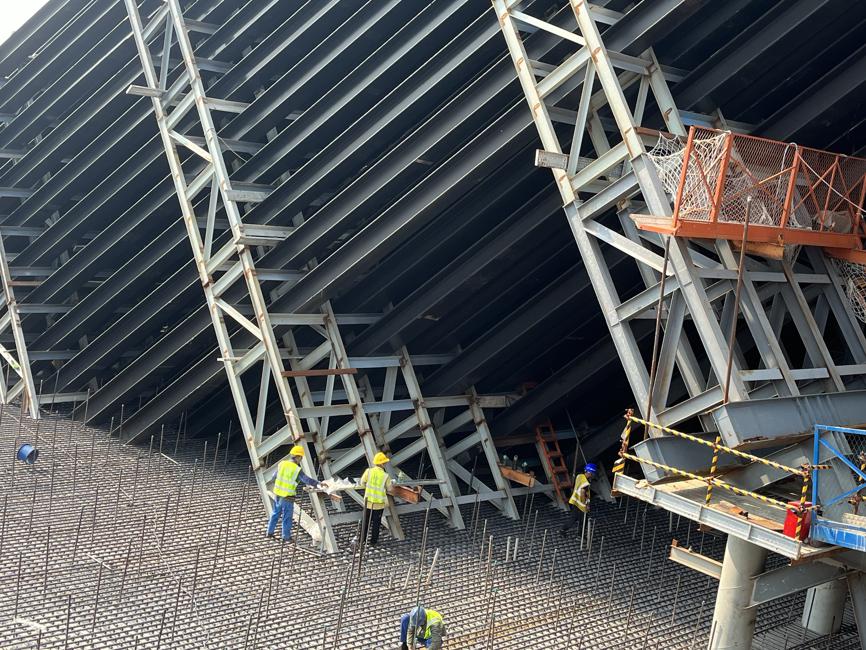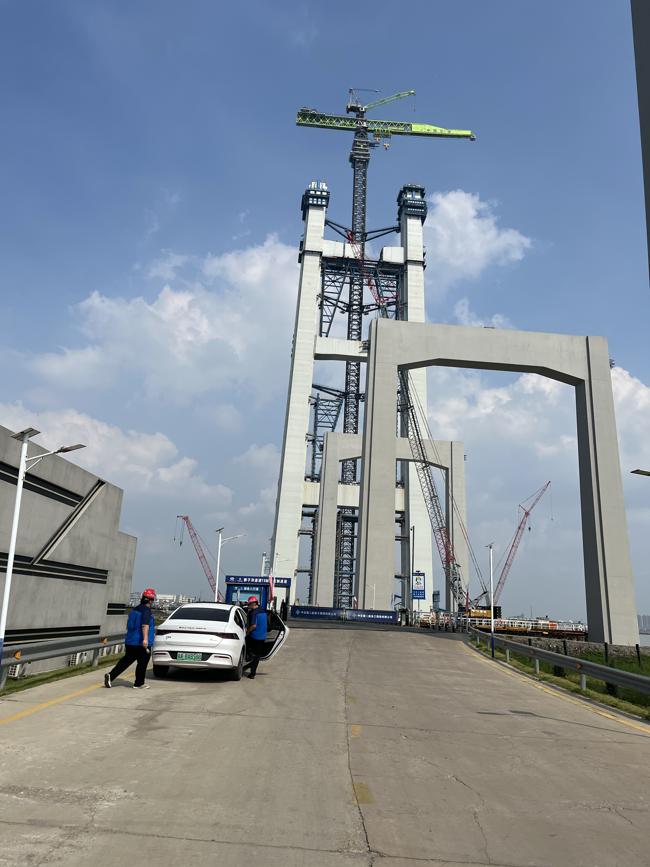
Workers are racing against time to advance construction of key nodes of Shiziyang Link. [Photo by Zheng Caixiong/chinadaily.com.cn]
Construction of a new double-deck bridge across the Pearl River estuary is progressing proactively in South China's Guangdong province, with workers racing against time to advance key nodes, demonstrating China's infrastructure construction capability and speed.
Zhang Taike, chief engineer of the project, the double-deck steel truss suspension bridge, said now more than 35 percent of the Shiziyang Link has been completed, and the 342-meter-high main tower is expected to be completed in March.
The project, with a main span of 2,180 meters, is estimated to be completed and traffic will begin in 2028. Shiziyang Link, whose construction started in 2023, is another mega infrastructural project running across the Pearl River estuary, following the Hong Kong-Zhuhai-Macao Bridge and Shenzhen-Zhongshan Link that officially started operation last year. Both HZMB, which started traffic in 2018, and Shenzhen-Zhongshan Link are mega structures that consist of bridges, tunnels, and artificial islands.
As a vital transportation artery for the southward and westward expansion of the Guangdong-Hong Kong-Macao Greater Bay Area, Shiziyang Link will be able to play a pivotal role in enhancing comprehensive connectivity between the eastern and western city clusters on both banks of the Pearl River Estuary, Zhang said.
It will also help accelerate the integrated development among the three regions of Guangdong, Hong Kong and Macao special administrative regions.
"Upon completion of the project, travel time between Guangzhou's Nansha and Dongguan will be significantly reduced. And this will not only foster closer integration among core cities in the Pearl River delta, but also enable more efficient cross-river circulation of industrial chains, talent flow, and logistics in the region," Zhang said.
Shiziyang Link connects the cities in GBA to major cities across the country through the region's advanced expressway network.

The 342-meter-high main tower of Shiziyang Link is expected to be completed in March. [Photo by Zheng Caixiong/chinadaily.com.cn]
Previously, the projections for economic development tended to be on the conservative side, said Zhang, adding that all the across-sea links in the regions, including Shenzhen-Zhongshan Link, Nansha, Humen, and Huangpu bridges, operated in red (all witnessed heavy traffic jams) during the National Day and Mid-Autumn festival holidays in the first eight days of October.
Shiziyang Link that connects Guangzhou's Nansha district and Dongguan is sandwiched by Nansha Bridge, 3.8 kilometers to the north, and Humen Bridge, 7.7 kilometers to the south. It is designed to reach a speed of 100 kilometers an hour.
Cui Bing, a National Master of Engineering Survey and Design, said the state of the art project leads the world in diameter of the anchor foundation (130 meters), height of steel plate composite tower (342 meters), span of double-layer suspension bridge (2,180 meters), scale of main Cable (1.5 meter-diameter) and number of lanes (double-deck two-way 8 lanes ).
The bridge's "world firsts" might not be the first in 10 to 20 years, but the design, technology, philosophy, methods, and structure of the bridge will influence the design and construction of bridges worldwide in the future, said Cui, who is chief engineer of China Communications Construction Company (CCCC) Highway Consultants Co Ltd.
"And the design of the project adheres to the principles of economy, applicability, greenness, durability, and resistance to multiple disasters," he added.
Meanwhile, Lianghuashan Link, which links Guangzhou's Panyu district to Dongguan city has also been planned and is expected to start construction in the 15th five-year-plan period 2026-30, said Xu Jun, deputy chief engineer of CCCC Highway Consultants Co Ltd. Relevant departments will soon decide whether it is a bridge or tunnel that operates across the Pearl River estuary.
And the Lingdingyang Link, which connects Shenzhen and Zhuhai, has also been planned to further advance ties between the two Chinese special economic zones. Lingdingyang Link will be a railway and highway dual-purpose link.






